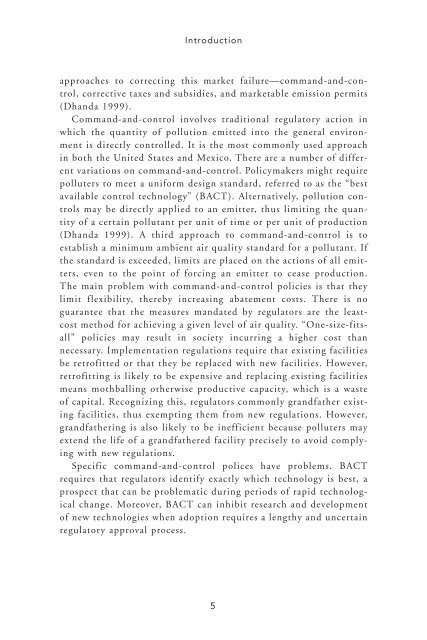Entire Book - Southwest Consortium for Environmental Research ...
Entire Book - Southwest Consortium for Environmental Research ...
Entire Book - Southwest Consortium for Environmental Research ...
You also want an ePaper? Increase the reach of your titles
YUMPU automatically turns print PDFs into web optimized ePapers that Google loves.
Introduction<br />
approaches to correcting this market failure—command-and-control,<br />
corrective taxes and subsidies, and marketable emission permits<br />
(Dhanda 1999).<br />
Command-and-control involves traditional regulatory action in<br />
which the quantity of pollution emitted into the general environment<br />
is directly controlled. It is the most commonly used approach<br />
in both the United States and Mexico. There are a number of different<br />
variations on command-and-control. Policymakers might require<br />
polluters to meet a uni<strong>for</strong>m design standard, referred to as the “best<br />
available control technology” (BACT). Alternatively, pollution controls<br />
may be directly applied to an emitter, thus limiting the quantity<br />
of a certain pollutant per unit of time or per unit of production<br />
(Dhanda 1999). A third approach to command-and-control is to<br />
establish a minimum ambient air quality standard <strong>for</strong> a pollutant. If<br />
the standard is exceeded, limits are placed on the actions of all emitters,<br />
even to the point of <strong>for</strong>cing an emitter to cease production.<br />
The main problem with command-and-control policies is that they<br />
limit flexibility, thereby increasing abatement costs. There is no<br />
guarantee that the measures mandated by regulators are the leastcost<br />
method <strong>for</strong> achieving a given level of air quality. “One-size-fitsall”<br />
policies may result in society incurring a higher cost than<br />
necessary. Implementation regulations require that existing facilities<br />
be retrofitted or that they be replaced with new facilities. However,<br />
retrofitting is likely to be expensive and replacing existing facilities<br />
means mothballing otherwise productive capacity, which is a waste<br />
of capital. Recognizing this, regulators commonly grandfather existing<br />
facilities, thus exempting them from new regulations. However,<br />
grandfathering is also likely to be inefficient because polluters may<br />
extend the life of a grandfathered facility precisely to avoid complying<br />
with new regulations.<br />
Specific command-and-control polices have problems. BACT<br />
requires that regulators identify exactly which technology is best, a<br />
prospect that can be problematic during periods of rapid technological<br />
change. Moreover, BACT can inhibit research and development<br />
of new technologies when adoption requires a lengthy and uncertain<br />
regulatory approval process.<br />
5









